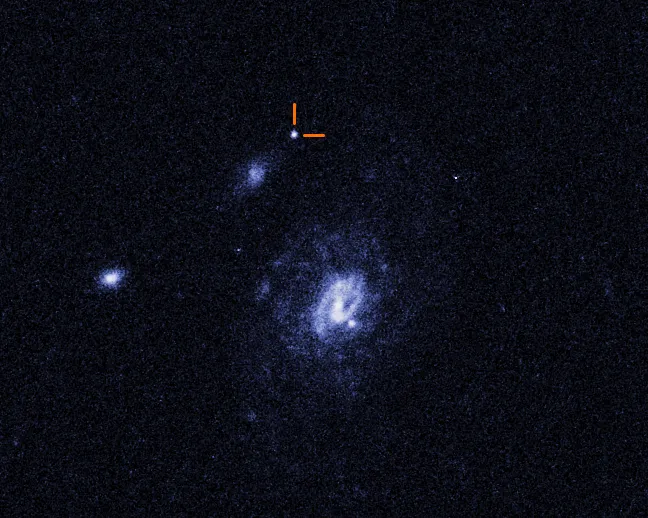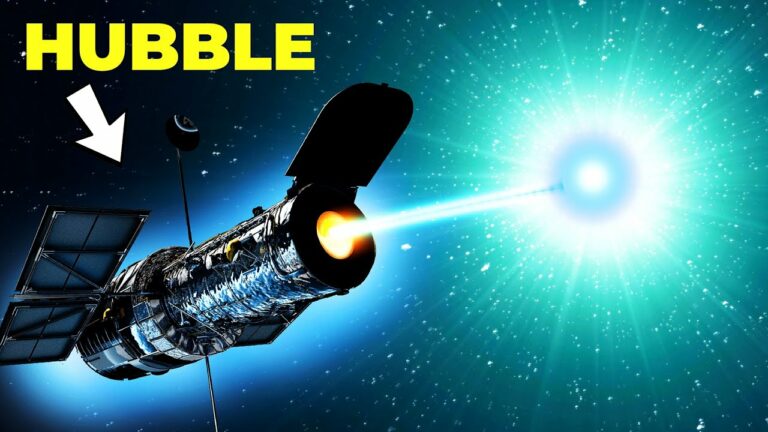NASA’s Hubble Space Telescope has added an extra layer of intrigue to an already baffling occurrence in the cosmos: a remarkably rare burst of brilliantly luminous light that defies explanation.
This extraordinary event, known as a Luminous Fast Blue Optical Transient (LFBOT), manifested in an entirely unexpected location, far removed from any galactic host. It was the astute discernment of Hubble that pinpointed its whereabouts. Yet, rather than shedding light on the nature of LFBOTs, the results have plunged astronomers further into perplexity. Initially ignorant of what LFBOTs truly are, the Hubble data has now muddled the waters by negating certain plausible hypotheses.
LFBOTs rank among the most radiant visible-light occurrences in the universe, bursting forth without warning, akin to camera flashbulbs. Since their debut discovery in 2018, with the enigmatic event dubbed “the Cow” located approximately 200 million light-years away, only a handful of LFBOTs have been identified. Currently, they appear once a year.
In the aftermath of its initial spotting, the most recent LFBOT, dubbed “the Finch” (officially designated as AT2023fhn), underwent scrutiny by multiple telescopes spanning the electromagnetic spectrum, encompassing X-rays to radio waves. The transient event exhibited all the signature traits of an LFBOT: an intense azure luminosity that evolved rapidly, attaining peak brightness and then dimming within days, a stark contrast to the gradual fading of supernovae over weeks or months.
However, the Finch diverges markedly from previous LFBOTs. Hubble’s revelations unveiled that it resides in the interstellar expanse nestled between two adjacent galaxies, positioned approximately 50,000 light-years from a neighboring spiral galaxy and about 15,000 light-years from a smaller galaxy.
Ashley Chrimes, the lead author of the Hubble paper detailing this discovery in an upcoming issue of the Monthly Notices of the Royal Astronomical Society (MNRAS), emphasized the pivotal role played by Hubble’s observations. Without the data supplied by the telescope, this anomaly would have remained undetected. Chrimes, formerly affiliated with Radboud University, Nijmegen, Netherlands, and currently an European Space Agency Research Fellow, conveyed the significance of Hubble’s contribution to unraveling this cosmic enigma.

NASA, ESA, STScI, Ashley Chrimes (ESA-ESTEC/Radboud University)
While these extraordinary bursts of light have commonly been attributed to a rare class of supernovae known as core-collapse supernovae, the massive stars that give rise to these supernovae have relatively short lifespans in astronomical terms. As a result, they typically do not have the opportunity to migrate far from their birthplace, often within a cluster of newly formed stars, before their cataclysmic explosions occur. Notably, all previously identified Luminous Fast Blue Optical Transients (LFBOTs) have been located in the spiral arms of galaxies characterized by ongoing star formation. However, the case of “the Finch” is distinctly different as it does not belong to any particular galaxy.
Ashley Chrimes remarked, “The more we learn about LFBOTs, the more they surprise us. We’ve now shown that LFBOTs can occur a long way from the center of the nearest galaxy, and the location of the Finch is not what we expect for any kind of supernova.”
The Zwicky Transient Facility, an expansive ground-based camera with an exceptionally wide field of view that scans the entire northern sky every two days, initially detected the Finch on April 10, 2023. Once its presence was confirmed, the researchers initiated a prearranged sequence of observations that had been prepared in advance, ready to be activated whenever potential LFBOT candidates emerged.
Using spectroscopic measurements obtained with the Gemini South telescope in Chile, the researchers determined that the Finch’s temperature was an scorching 36,000 degrees Fahrenheit. Gemini also played a key role in ascertaining the Finch’s distance from Earth, facilitating the calculation of its luminosity. These observations, combined with data from other observatories including NASA’s Chandra X-ray Observatory and the National Science Foundation’s Very Large Array radio telescopes, conclusively affirmed the nature of the explosion as an LFBOT.
The enigmatic origins of LFBOTs have led researchers to explore various hypotheses, one of which involves the possibility that they result from the gravitational forces exerted by an intermediate-mass black hole, with a mass ranging from 100 to 1,000 times that of the Sun. NASA’s James Webb Space Telescope, with its high resolution and infrared sensitivity, may ultimately provide insights into the possibility that the Finch exploded within a globular star cluster located in the outer halo of one of the two neighboring galaxies. Such clusters represent the most likely environments for the presence of intermediate-mass black holes.
In explaining the unexpected location of the Finch, researchers are considering the scenario of a collision between two neutron stars that have spiraled toward each other over billions of years, resulting in an explosion known as a kilonova, which is approximately 1,000 times more powerful than a typical nova. A highly speculative theory posits that if one of the neutron stars is a magnetar, possessing substantial magnetism, it could significantly amplify the explosion’s intensity to 100 times that of a standard supernova.
Ashley Chrimes concluded, “The discovery poses many more questions than it answers. More work is needed to figure out which of the many possible explanations is the right one.”
Given the unpredictable nature and fleeting duration of astronomical transients, researchers depend on wide-field surveys that continuously monitor large regions of the sky to detect such phenomena and alert other observatories, including Hubble, for follow-up observations.
To gain a deeper understanding of this phenomenon, researchers stress the need for a more extensive sample of LFBOTs. Upcoming all-sky survey telescopes, such as the ground-based Vera C. Rubin Observatory, may offer opportunities for additional detections, contingent upon the underlying astrophysical mechanisms at play.
The Hubble Space Telescope represents a collaborative effort between NASA and ESA. NASA’s Goddard Space Flight Center, situated in Greenbelt, Maryland, oversees the telescope’s management. The Space Telescope Science Institute (STScI) in Baltimore, Maryland, is responsible for conducting scientific operations for both Hubble and the James Webb Space Telescope, operating on behalf of NASA through the Association of Universities for Research in Astronomy, located in Washington, D.C.
This article is republished from NASA under a Creative Commons license. Read the original article.
Do not forget to share your opinion with us to provide you with the best posts !




0 Comments